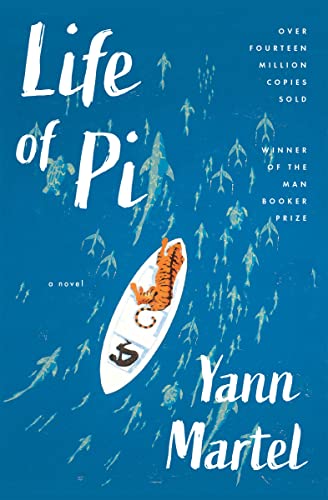Welcome! This is my review of a book that people either love or throw across the room: Life of Pi. I read this with a bunch of friends and ended up arguing about tigers, faith, and bananas for hours. If you want a story about survival (but with more mystery and less Bear Grylls), talking about belief and what’s actually true, and if you think you could share a boat with a wild animal, you’re in the right spot. Let’s see if this book is worth its sea salt—or if it just made me seasick.
Life of Pi Book Review
In a nutsheel
Life of Pi is a wild and weird adventure novel by Yann Martel. The story follows Pi Patel, a teenage boy who gets stuck on a lifeboat. But Pi is not alone—he’s got a Bengal tiger for company! You read that right: a real, grumpy tiger. This book mixes survival drama with some deep thinking on faith, hope, and what makes us tick.
You’ll find yourself asking big questions while also sweating over who is going to eat who first. The story is a blend of adventure, magic realism, and a bit of philosophy, all packed into not too many pages. It’s a book that makes you think and keeps you guessing, but won’t totally fry your brain like some of those big, fancy classics.
So, if you want a book that is smart, sometimes funny, and has more animal action than a trip to the zoo, Life of Pi might just float your boat. (See what I did there?)
Survival and Resilience at Sea: Lessons from Life of Pi
Imagine being stranded in the ocean, only you don’t have a yacht, a volleyball named Wilson, or even snacks. You’ve just got a lifeboat, a handful of supplies, and, oh yes, a Bengal tiger. That’s the world Pi Patel finds himself in the book Life of Pi by Yann Martel. If you ever thought your camping trips were tough, try sharing your tent with a 450-pound cat who isn’t keen on cuddles.
This book reminded me of the time I tried to survive a weekend with only one frozen pizza. Sure, I didn’t have to battle the high seas or keep a wild animal happy, but the feeling of “will I make it?” was there. Pi, on the other hand, has to get creative just to stay alive. He builds rafts out of life jackets, fishes with whatever he can find, and even sets boundaries with the tiger using a whistle. Tips for dealing with hungry tigers sadly aren’t covered in most survival guides.
What makes Life of Pi special is how it makes you root for a kid who could have given up at any moment. Pi fights storms, hunger, and fear. The book paints a picture of what happens when your only friend is a possible meal, and your biggest problem is staying both sane and not eaten. It’s a wild ride that makes you question your own survival skills. (Pro tip: always pack extra snacks.)
If you think surviving with a tiger is dramatic, wait till you see how Pi’s struggles at sea shape his beliefs. Next up, we’ll talk about faith, belief, and personal growth. Get ready—things are about to get spiritual!
Faith, Belief, and the Crazy Roller Coaster of Personal Growth in Life of Pi
Okay, so let me tell you—the “Life of Pi” is not just about surviving in a boat with a cranky tiger. Nope. It’s also about faith and the wild, wobbly journey of believing in something bigger than yourself. When I read this book, I found myself rooting for Pi not just to stay alive, but to keep believing—even when the world handed him a bucket of lemons and said, “Ha! Good luck.”
Pi Patel isn’t your average teenager. He mixes religions like most people mix cereals—taking bits of Hinduism, Christianity, and Islam because he’s searching for meaning. I gotta admit, sometimes I felt like Pi was making my brain tie into knots with all that thinking. But honestly, his open mind is inspiring. He keeps his faith, even when the only thing around him is water, fear, and the occasional fish snack. Pi’s prayers and rituals don’t just fill pages; they keep him company and help him grow as a person. It’s like his belief is a life vest—without it, he might just sink. Also, there’s this wild bit where he thanks God for even the smallest wins (like not getting eaten by Richard Parker). Call me emotional, but that hit me right in the feels.
Even if you aren’t into religion, Pi’s faith invites you to ask yourself what you believe when things get tough. Next up, strap in as we paw our way into the world of human-animal relationships and the sneaky symbolism hiding in plain sight among the whiskers and stripes.
Exploring Human-Animal Bonds and Symbolism in Life of Pi
Let’s talk about animals. Not just any animals—zebra, orangutan, hyena, and a massive Bengal tiger named Richard Parker. Life of Pi is not just a story about a boy and a tiger on a raft. It’s a wild, tail-flicking journey into what it means to be human, when all you have for company is a 450-pound predator and some leftovers from a shipwreck.
If you ever wondered what it would be like to look a tiger in the eye while trying to eat a can of leftovers, Pi Patel gives you the answer: it’s scary, but you get used to it. The weirdest thing is, the tiger becomes more than just a hungry beast. Richard Parker turns into a strange kind of friend, or at least a roommate you learn to respect, feed and share very awkward silences with. I tried spending a weekend with my cousin’s cat for practice, and I still have the scratches.
But there’s more going on. Every animal on the boat is a symbol. Some say the animals represent different sides of Pi or even other humans he met on the boat. Honestly, it gets deep, fast, kind of like a philosophy class with fur and claws. The book throws you into a world where the survival rules are written in stripes and sharp teeth. The animal relationships test Pi’s limits and show how humans and beasts shape each other’s journey.
And just when you think you’ve figured out who’s who, the story takes a twist. But more about stories—and who’s telling them—in our next section about Storytelling and unreliable narration. Buckle up!
Storytelling and Unreliable Narration in Life of Pi
Let’s talk about one of my favorite things from Life of Pi: the whole storytelling business. You know that feeling when your friend promises a wild story, but halfway through you start wondering if he’s just making stuff up? That’s the vibe I got here. The whole story is Pi telling us what happened after his shipwreck—except, Pi’s idea of the truth seems as slippery as a wet fish.
Yann Martel doesn’t just serve a plain tale. He gives us a mystery sundae with extra fudge. We get a magical lifeboat story with a Bengal tiger and then, just as we’re starting to trust Pi, BOOM—he flips the script and offers a second version that’s darker and way more human (and honestly, way more disturbing). Which one is true? Both? Neither? I felt like I needed a detective hat and a big red pen to keep up.
For me, this makes the book twice as interesting. You’re not just reading about shipwrecks and wild animals; you’re also guessing at every turn if Pi is pulling your leg. It turns the act of storytelling into its own character, right alongside Pi and Richard Parker. I even started questioning how much I trust my own memories… and also if I could ever look at a tiger the same way again.
So do I recommend Life of Pi? If you like your books with a dash of mystery, a pinch of mind games, and a whole pack of wild stories, then yes! But if you want your stories neat and tidy, maybe keep rowing.
Conclusion
Alright, so that wraps up my wild ride with Life of Pi. This book serves up faith, survival, a lot of weird animal moments, and enough questions about truth to make your head spin. It kept me guessing (and sometimes hungry—I blame all the talk about food and fish). The writing sways between deep and playful, and even if Pi’s story gets a bit odd, it always made me want to flip another page. If you like stories about being stuck at sea with only your wits, some faith, and a huge tiger for company, this one’s worth a go. But heads up—be ready for some weirdness and a twist on what’s real and what’s not. That’s it for my review—thanks for sticking with me, and try not to get stranded on a lifeboat anytime soon!


